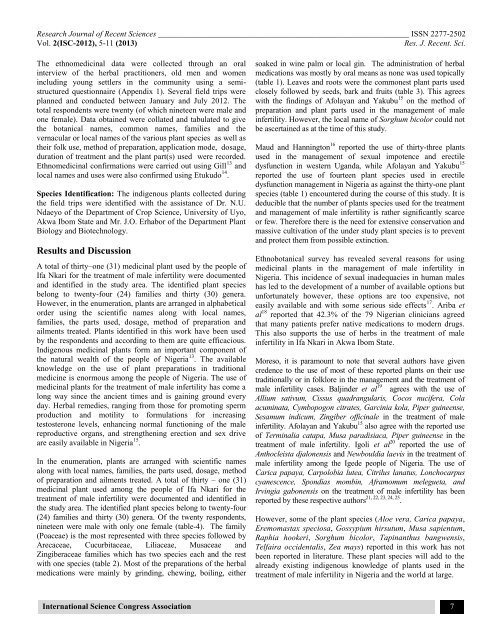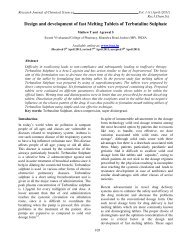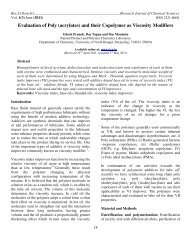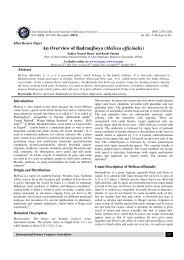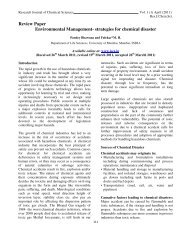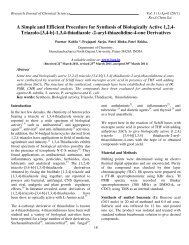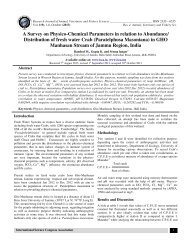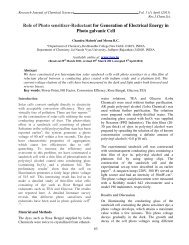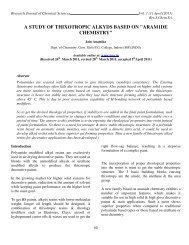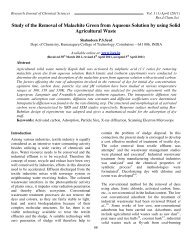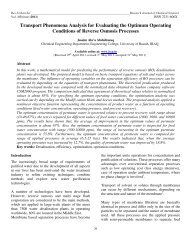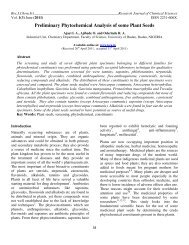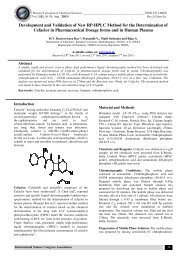Ethnomedicinal Survey of Medicinal Plants Used in the ... - ISCA
Ethnomedicinal Survey of Medicinal Plants Used in the ... - ISCA
Ethnomedicinal Survey of Medicinal Plants Used in the ... - ISCA
You also want an ePaper? Increase the reach of your titles
YUMPU automatically turns print PDFs into web optimized ePapers that Google loves.
Research Journal <strong>of</strong> Recent Sciences ______________________________________________________________ ISSN 2277-2502<br />
Vol. 2(ISC-2012), 5-11 (2013)<br />
Res. J. Recent. Sci.<br />
The ethnomedic<strong>in</strong>al data were collected through an oral<br />
<strong>in</strong>terview <strong>of</strong> <strong>the</strong> herbal practitioners, old men and women<br />
<strong>in</strong>clud<strong>in</strong>g young settlers <strong>in</strong> <strong>the</strong> community us<strong>in</strong>g a semistructured<br />
questionnaire (Appendix 1). Several field trips were<br />
planned and conducted between January and July 2012. The<br />
total respondents were twenty (<strong>of</strong> which n<strong>in</strong>eteen were male and<br />
one female). Data obta<strong>in</strong>ed were collated and tabulated to give<br />
<strong>the</strong> botanical names, common names, families and <strong>the</strong><br />
vernacular or local names <strong>of</strong> <strong>the</strong> various plant species as well as<br />
<strong>the</strong>ir folk use, method <strong>of</strong> preparation, application mode, dosage,<br />
duration <strong>of</strong> treatment and <strong>the</strong> plant part(s) used were recorded.<br />
<strong>Ethnomedic<strong>in</strong>al</strong> confirmations were carried out us<strong>in</strong>g Gill 13 and<br />
local names and uses were also confirmed us<strong>in</strong>g Etukudo 14 .<br />
Species Identification: The <strong>in</strong>digenous plants collected dur<strong>in</strong>g<br />
<strong>the</strong> field trips were identified with <strong>the</strong> assistance <strong>of</strong> Dr. N.U.<br />
Ndaeyo <strong>of</strong> <strong>the</strong> Department <strong>of</strong> Crop Science, University <strong>of</strong> Uyo,<br />
Akwa Ibom State and Mr. J.O. Erhabor <strong>of</strong> <strong>the</strong> Department Plant<br />
Biology and Biotechnology.<br />
Results and Discussion<br />
A total <strong>of</strong> thirty–one (31) medic<strong>in</strong>al plant used by <strong>the</strong> people <strong>of</strong><br />
Ifa Nkari for <strong>the</strong> treatment <strong>of</strong> male <strong>in</strong>fertility were documented<br />
and identified <strong>in</strong> <strong>the</strong> study area. The identified plant species<br />
belong to twenty-four (24) families and thirty (30) genera.<br />
However, <strong>in</strong> <strong>the</strong> enumeration, plants are arranged <strong>in</strong> alphabetical<br />
order us<strong>in</strong>g <strong>the</strong> scientific names along with local names,<br />
families, <strong>the</strong> parts used, dosage, method <strong>of</strong> preparation and<br />
ailments treated. <strong>Plants</strong> identified <strong>in</strong> this work have been used<br />
by <strong>the</strong> respondents and accord<strong>in</strong>g to <strong>the</strong>m are quite efficacious.<br />
Indigenous medic<strong>in</strong>al plants form an important component <strong>of</strong><br />
<strong>the</strong> natural wealth <strong>of</strong> <strong>the</strong> people <strong>of</strong> Nigeria 13 . The available<br />
knowledge on <strong>the</strong> use <strong>of</strong> plant preparations <strong>in</strong> traditional<br />
medic<strong>in</strong>e is enormous among <strong>the</strong> people <strong>of</strong> Nigeria. The use <strong>of</strong><br />
medic<strong>in</strong>al plants for <strong>the</strong> treatment <strong>of</strong> male <strong>in</strong>fertility has come a<br />
long way s<strong>in</strong>ce <strong>the</strong> ancient times and is ga<strong>in</strong><strong>in</strong>g ground every<br />
day. Herbal remedies, rang<strong>in</strong>g from those for promot<strong>in</strong>g sperm<br />
production and motility to formulations for <strong>in</strong>creas<strong>in</strong>g<br />
testosterone levels, enhanc<strong>in</strong>g normal function<strong>in</strong>g <strong>of</strong> <strong>the</strong> male<br />
reproductive organs, and streng<strong>the</strong>n<strong>in</strong>g erection and sex drive<br />
are easily available <strong>in</strong> Nigeria 15 .<br />
In <strong>the</strong> enumeration, plants are arranged with scientific names<br />
along with local names, families, <strong>the</strong> parts used, dosage, method<br />
<strong>of</strong> preparation and ailments treated. A total <strong>of</strong> thirty – one (31)<br />
medic<strong>in</strong>al plant used among <strong>the</strong> people <strong>of</strong> Ifa Nkari for <strong>the</strong><br />
treatment <strong>of</strong> male <strong>in</strong>fertility were documented and identified <strong>in</strong><br />
<strong>the</strong> study area. The identified plant species belong to twenty-four<br />
(24) families and thirty (30) genera. Of <strong>the</strong> twenty respondents,<br />
n<strong>in</strong>eteen were male with only one female (table-4). The family<br />
(Poaceae) is <strong>the</strong> most represented with three species followed by<br />
Arecaceae, Cucurbitaceae, Liliaceae, Musaceae and<br />
Z<strong>in</strong>giberaceae families which has two species each and <strong>the</strong> rest<br />
with one species (table 2). Most <strong>of</strong> <strong>the</strong> preparations <strong>of</strong> <strong>the</strong> herbal<br />
medications were ma<strong>in</strong>ly by gr<strong>in</strong>d<strong>in</strong>g, chew<strong>in</strong>g, boil<strong>in</strong>g, ei<strong>the</strong>r<br />
soaked <strong>in</strong> w<strong>in</strong>e palm or local g<strong>in</strong>. The adm<strong>in</strong>istration <strong>of</strong> herbal<br />
medications was mostly by oral means as none was used topically<br />
(table 1). Leaves and roots were <strong>the</strong> commonest plant parts used<br />
closely followed by seeds, bark and fruits (table 3). This agrees<br />
with <strong>the</strong> f<strong>in</strong>d<strong>in</strong>gs <strong>of</strong> Afolayan and Yakubu 15 on <strong>the</strong> method <strong>of</strong><br />
preparation and plant parts used <strong>in</strong> <strong>the</strong> management <strong>of</strong> male<br />
<strong>in</strong>fertility. However, <strong>the</strong> local name <strong>of</strong> Sorghum bicolor could not<br />
be ascerta<strong>in</strong>ed as at <strong>the</strong> time <strong>of</strong> this study.<br />
Maud and Hann<strong>in</strong>gton 16 reported <strong>the</strong> use <strong>of</strong> thirty-three plants<br />
used <strong>in</strong> <strong>the</strong> management <strong>of</strong> sexual impotence and erectile<br />
dysfunction <strong>in</strong> western Uganda, while Afolayan and Yakubu 15<br />
reported <strong>the</strong> use <strong>of</strong> fourteen plant species used <strong>in</strong> erectile<br />
dysfunction management <strong>in</strong> Nigeria as aga<strong>in</strong>st <strong>the</strong> thirty-one plant<br />
species (table 1) encountered dur<strong>in</strong>g <strong>the</strong> course <strong>of</strong> this study. It is<br />
deducible that <strong>the</strong> number <strong>of</strong> plants species used for <strong>the</strong> treatment<br />
and management <strong>of</strong> male <strong>in</strong>fertility is ra<strong>the</strong>r significantly scarce<br />
or few. Therefore <strong>the</strong>re is <strong>the</strong> need for extensive conservation and<br />
massive cultivation <strong>of</strong> <strong>the</strong> under study plant species is to prevent<br />
and protect <strong>the</strong>m from possible ext<strong>in</strong>ction.<br />
Ethnobotanical survey has revealed several reasons for us<strong>in</strong>g<br />
medic<strong>in</strong>al plants <strong>in</strong> <strong>the</strong> management <strong>of</strong> male <strong>in</strong>fertility <strong>in</strong><br />
Nigeria. This <strong>in</strong>cidence <strong>of</strong> sexual <strong>in</strong>adequacies <strong>in</strong> human males<br />
has led to <strong>the</strong> development <strong>of</strong> a number <strong>of</strong> available options but<br />
unfortunately however, <strong>the</strong>se options are too expensive, not<br />
easily available and with some serious side effects 17 . Ariba et<br />
al 18 reported that 42.3% <strong>of</strong> <strong>the</strong> 79 Nigerian cl<strong>in</strong>icians agreed<br />
that many patients prefer native medications to modern drugs.<br />
This also supports <strong>the</strong> use <strong>of</strong> herbs <strong>in</strong> <strong>the</strong> treatment <strong>of</strong> male<br />
<strong>in</strong>fertility <strong>in</strong> Ifa Nkari <strong>in</strong> Akwa Ibom State.<br />
Moreso, it is paramount to note that several authors have given<br />
credence to <strong>the</strong> use <strong>of</strong> most <strong>of</strong> <strong>the</strong>se reported plants on <strong>the</strong>ir use<br />
traditionally or <strong>in</strong> folklore <strong>in</strong> <strong>the</strong> management and <strong>the</strong> treatment <strong>of</strong><br />
male <strong>in</strong>fertility cases. Balj<strong>in</strong>der et al 19 agrees with <strong>the</strong> use <strong>of</strong><br />
Allium sativum, Cissus quadrangularis, Cocos nucifera, Cola<br />
acum<strong>in</strong>ata, Cymbopogon citrates, Garc<strong>in</strong>ia kola, Piper gu<strong>in</strong>eense,<br />
Sesamum <strong>in</strong>dicum, Z<strong>in</strong>giber <strong>of</strong>fic<strong>in</strong>ale <strong>in</strong> <strong>the</strong> treatment <strong>of</strong> male<br />
<strong>in</strong>fertility. Afolayan and Yakubu 15 also agree with <strong>the</strong> reported use<br />
<strong>of</strong> Term<strong>in</strong>alia catapa, Musa paradisiaca, Piper gu<strong>in</strong>eense <strong>in</strong> <strong>the</strong><br />
treatment <strong>of</strong> male <strong>in</strong>fertility. Igoli et al 20 reported <strong>the</strong> use <strong>of</strong><br />
Anthocleista djalonensis and Newbouldia laevis <strong>in</strong> <strong>the</strong> treatment <strong>of</strong><br />
male <strong>in</strong>fertility among <strong>the</strong> Igede people <strong>of</strong> Nigeria. The use <strong>of</strong><br />
Carica papaya, Carpolobia lutea, Citrilus lanatus, Lonchocarpus<br />
cyanescence, Spondias momb<strong>in</strong>, Aframomum melegueta, and<br />
Irv<strong>in</strong>gia gabonensis on <strong>the</strong> treatment <strong>of</strong> male <strong>in</strong>fertility has been<br />
reported by <strong>the</strong>se respective authors 21, 22, 23, 24, 25 .<br />
However, some <strong>of</strong> <strong>the</strong> plant species (Aloe vera, Carica papaya,<br />
Eremomastax speciosa, Gossypium hirsutum, Musa sapientum,<br />
Raphia hookeri, Sorghum bicolor, Tap<strong>in</strong>anthus bangwensis,<br />
Telfaira occidentalis, Zea mays) reported <strong>in</strong> this work has not<br />
been reported <strong>in</strong> literature. These plant species will add to <strong>the</strong><br />
already exist<strong>in</strong>g <strong>in</strong>digenous knowledge <strong>of</strong> plants used <strong>in</strong> <strong>the</strong><br />
treatment <strong>of</strong> male <strong>in</strong>fertility <strong>in</strong> Nigeria and <strong>the</strong> world at large.<br />
International Science Congress Association 7


